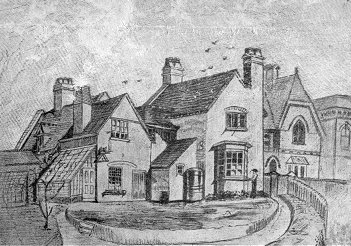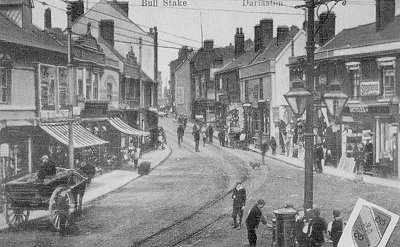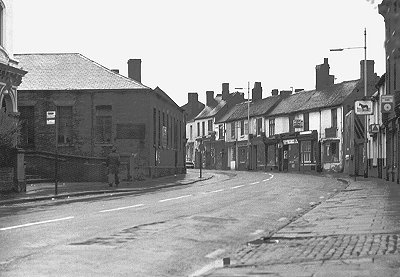|
The
Increasing Population & Social Conditions in the First
Half of the 19th Century.
At the beginning of the 19th century,
the overcrowding caused by a rapidly increasing
population hadn't really began. There were sufficient
houses, and employment for everyone. The figures from
the 1801 census are as follows:
|
population |
|
3,812 |
| number
of males |
|
1,996 |
| number
of females |
|
1,816 |
| number
of inhabited houses |
|
703 |
| number
of uninhabited houses |
|
59 |
| number
of families in the houses |
|
777 |
| people
employed in agriculture |
|
35 |
| people
employed in manufacture and handicrafts |
|
1325 |
| people
in other employment |
|
2452 |
During the Napoleonic wars when the gun
trade was booming, local people used to boast that
Darlaston had more money per square inch than any other
town in Great Britain. Money was so plentiful that many
of the people employed in the gun trade used to squander
it, and large amounts of fish and meat were sold here.
Business was also booming for shopkeepers, and many
people seeking employment were attracted to the town,
which continued throughout the century. |
|
Year |
Population |
|
1801 |
3,812 |
|
1811 |
4,900 |
|
1821 |
5,600 |
|
1831 |
6,600 |
|
1841 |
8,200 |
|
1851 |
10,591 |
|
1866 |
12,884 |
|
1870 |
14,724 |
|
1881 |
13,600 |
|
1891 |
14,400 |
|
1901 |
15,395 |
| Even though the population increased, adequate
housing, drainage, and sanitation were not provided
very quickly. This produced an extremely high death
rate, and Darlaston was described as the
unhealthiest town in the black country. Houses fell
into two broad categories, those for the rich, and
those for the poor. The houses for the rich compared
favourably with similar dwellings elsewhere, but
many of the poor lived in dreadful conditions. The
worst houses were those in the notorious courts.
Houses were crammed into any available space, many
being built behind existing houses. As many as ten
houses were built into a courtyard, with perhaps
sixty people sharing common wash houses and toilets.
Some of the very poor had to use boxes as tables and
chairs, and it was not uncommon for people to sleep
on the floor, with sacking and old clothing for
bedding. |

A view of the back of the Adams
family's house in Pinfold Street. On the right is the
Wesleyan Chapel and to its left part of the minister's
house. From the Methodist Recorder 13th June, 1901. |
Coal was the main source of heat and power. Smoke
poured from domestic and factory chimneys in vast
clouds, which created a permanent canopy over the entire
district. Soot often formed a coating on buildings, and
soot spots used to appear on washing hung out to dry.
The coal fires produced large quantities of ash. There
were no sewers, and the toilets were emptied
periodically by the night-soil men, who carried out
their unsavoury task while everyone else slept. The
contents of the toilets were mixed with the ashes, and
transported by wheelbarrow to an awaiting cart in the
street. |
| The refuse was then transported to dumps in various
parts of the town, one of which could be found in
Darlaston Road on the site of the Servis factory. The
smell was extremely unpleasant, as you can imagine.
Accommodation was often supplied by publicans who were
amongst the most affluent members of the community.
Sometimes they provided finance for the building of
houses, but more often they purchased plots of land,
divided them up into streets, and sold building plots to
builders or private individuals. Some of these streets
were named after them; Aldridge Street, Corns Street,
and Foster Street. One such landlord, Charles Foster of
the Bell Inn, purchased a piece of land known as Wilkes'
and Shale's Crofts and divided it up into building
plots. He had roads built and called the development
"Charles Foster's Building estate. Plots were sold by
private contract or at an auction held at the Bell on
2nd May, 1836. This development included Foster Street.
A new parish workhouse opened in 1813 on a site near
the corner of St. Georges Street and The Green. It
closed in 1838 on the formation of the Walsall Poor Law
Union, whose buildings now form the older part of the
Manor Hospital. Their workhouse in Pardoes Lane (now
Victoria Road) was demolished in 1887 to make way for
the Town Hall. The workhouse was established to cope
with the vast numbers of poor and vagrants produced by
an unequal society, and unstable economy. It was not
intended as a shelter, but as a place of work, life
being both unpleasant and degrading.
The Parish Workhouse included a lock-up, an early
prison cell. The Parish Constable in 1838 was Joseph
Golcher and when the workhouse closed he built a new
lock-up at the rear of his own house. This continued in
use until he retired. The town also had a whipping post
and Parish stocks at Rock's Fold near the Bell Inn,
Church Street. When the stocks were eventually removed
they were stored at the house of the acting constable
and later mounted on wheels. Anyone condemned to the
stocks would be wheeled around from place to place as
part of the punishment. |

The Bull Stake & King Street
around 1907. From an old postcard |
At about this time the face of King Street was
starting to change. It originally contained many
attractive houses that were occupied by some of the
wealthier citizens. The Poor Law Relief Rate Book of
1800 states that in 1793 there were 50 substantial
houses, and 16 houses combined with some sort of
business. Most of these consisted of small workshops,
and in some cases they had a small retail shop attached,
in which was sold the produce from the workshop. |
Parson & Bradshaw's Directory of 1818 lists 11
retail businesses:
| 2 - |
Butchers |
| 1 - |
Baker & Maltster |
| 1 - |
Shoemaker |
| 1 - |
Linen & Woollen
Draper |
| 1 - |
Tailor |
| 1 - |
Saddler & Coach
Proprietor |
| 1 - |
Warehouseman |
| 3 - |
Shopkeepers |
Throughout the 19th century the houses were gradually
converted into shops, so that King Street became the
principal shopping street, as it is today. As industry
flourished and the population grew, the demand for local
shops increased. The numbers were as follows:
| 1834 - |
17 shops |
| 1845 - |
24 shops |
| 1855 - |
34 shops |
| |
|
 |
|
 |
Pigot & Co.
1828 directory |
|
Read an 1842
trade directory |
By 1850 a large variety of items could be purchased
in King Street, including; food, clothing, clocks,
watches, footwear, books, stationery, seeds, baskets.
There were 4 chemist shops, 2 house agents, and a fire
insurance agent. By the end of the century only two
houses remained, the others had been converted into
shops.
The row of shops in Pinfold Street were originally
private houses. Half were one up, one down workmen's
cottages. It was here that most of the victims of the
1831 cholera epidemic lived. Behind the houses ran a
ditch, dug to remove waste water from the factories at
Kings Hill. The water ran into a boggy area behind
Catherine's Cross. When it left the factories the water
was fairly clean, but along the way it was used as an
open sewer. By the time it reached Pinfold Street it was
very dirty and contaminated with the carrier of cholera.
There were 223 cases of cholera, and 68 deaths, most of
which were in Pinfold Street. Later, when the danger was
understood, the ditch was deepened, partly culverted,
and diverted into the canal at Porkett's Bridge.
|
| Read about Darlaston in
1851 |
 |
The photograph shows the Wesleyan
Methodist School on the left and the row of shops where
most of the victims of the 1831 cholera epidemic lived.
The Black Horse pub on the right was the oldest public
house in Darlaston, dating from the late 18th century.
It was the headquarters of the town's horse racing
fraternity. |

Pinfold Street in the early
1970's. |
 |
King Street from the Bull
Stake in the late 1950s, before its decline.
The shops on the opposite side of the road are L to R:
A. P. Appleyard. The Corner Shop, Collins shoe shop,
Careful Cleaners, and Middleton's Toy Shop.
|
 |
 |
 |
Return to Iron and
Steel Making |
Return to
Contents |
Proceed to The Grand JunctionRailway |
|